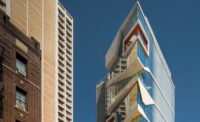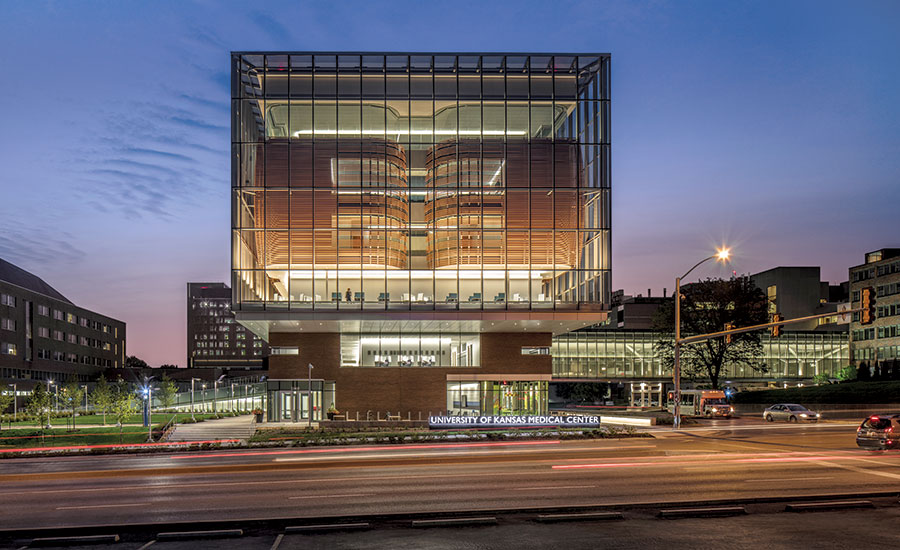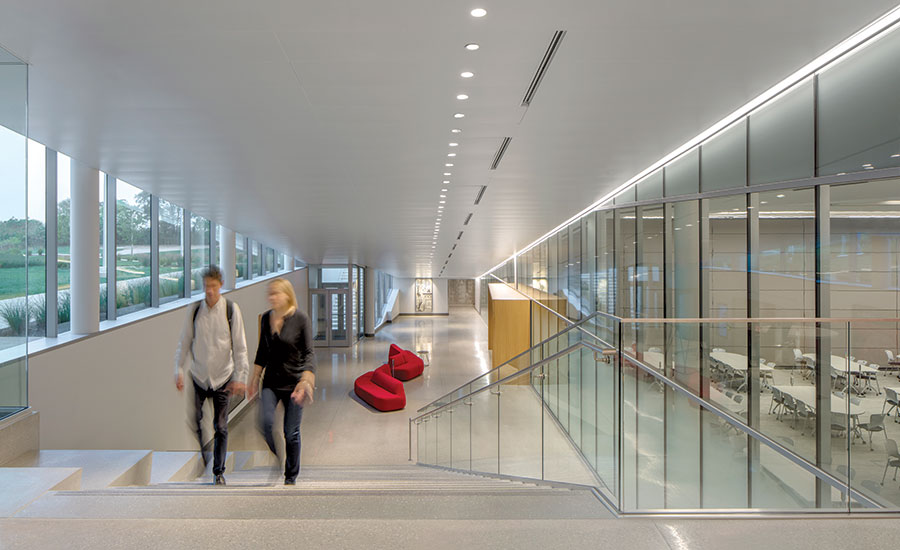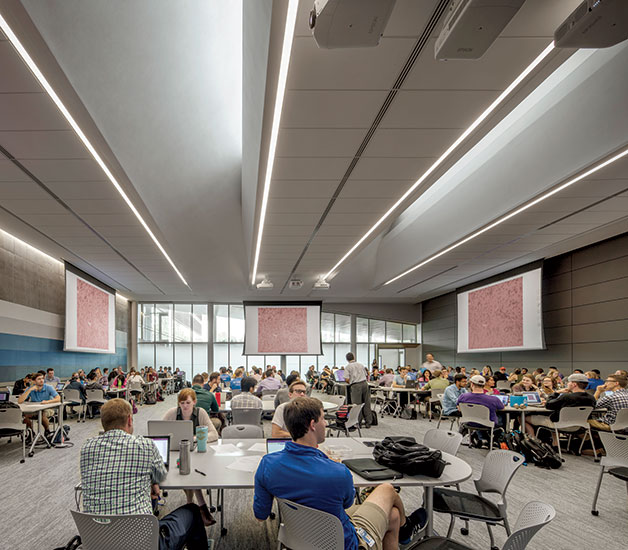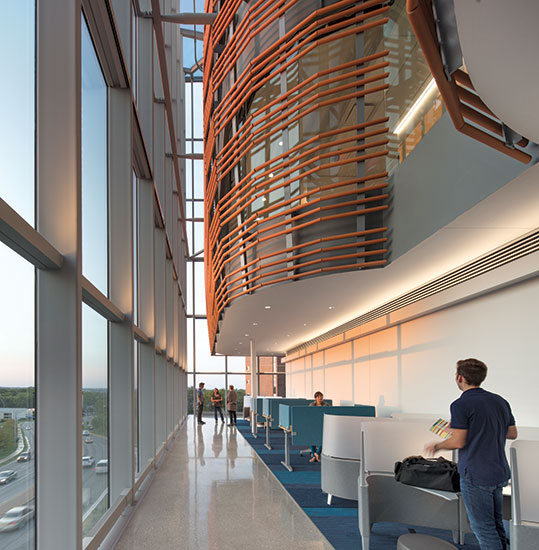KU Medical Center Health Education Building by CO Architects
Kansas City, Kansas

Photo © Bill Timmerman

The HEB dramatizes the entry point into the KU Medical Center.
Photo © Bill Timmerman

Students and faculty enter the studios through daylit gathering spaces.
Photo © Bill Timmerman

Simulation suites and other spaces occupy the glass-and-brick volume, while large learning studios are contained within the low-slung portion of the building, beneath the green roof.
Photo © Bill Timmerman

Mirrored windows into simulation rooms allow instructors to observe students during hands-on training exercises.
Photo © Bill Timmerman

Mirrored windows into simulation rooms allow instructors to observe students during hands-on training exercises.
Photo © Bill Timmerman

Carrels occupy the space below the terra-cotta baguettes.
Photo © Bill Timmerman

A glass-enclosed pedestrian bridge is also used for group study.
Photo © Bill Timmerman

Image courtesy CO Architects

Image courtesy CO Architects

Image courtesy CO Architects

Image courtesy CO Architects












Architects & Firms
While instruction at the Schools of Medicine, Nursing, and Health Professions at the University of Kansas (KU) long enjoyed a reputation of innovation and excellence, the aging facilities did not. Healthcare education has moved in directions that the designers of KU’s six classroom and lab buildings could never have anticipated. With two structures built in the 1930s and a third almost a century old, the university knew that adapting the edifices to meet new standards of health-care education was not an option.
Additional Content:
Jump to credits & specifications
In 2014, the medical school’s leadership seized upon the opportunity to design a new facility from the ground up. They chose Los Angeles–based CO Architects, along with executive architects Helix Architecture + Design, to create a center that would allow the school to incorporate simulations training, or “sims,” into its curricula in a major way while making space for a 25 percent increase in enrollment. More broadly, the architects were to create a building that, located on a prominent corner at the gateway to the campus, would make Kansans proud of the outstanding KU Health System.
The result is the 172,000-square-foot, six-story Health Education Building (HEB), oriented on an east–west axis overlooking two major streets. At the front, the top four levels are expressed as a cantilevered volume enclosed within a double-walled glass facade. “KU wanted this building to be a front door, and, at night, a lantern,” says Jon Kanda, principal of CO Architects. “Transparency and the use of glass became our modus operandi to achieve those effects.” Behind, to the east, the volume contains small learning studios, the mechanical core, and circulation. Here the facades are clad in roman brick and are slashed by strip windows and a masonry screen. An expansive one-story learning-studio wing with a green roof is sunk into the site to the northeast of the glazed volume, and a new glass-enclosed bridge connects the new building to the north with the existing buildings of the medical campus to the south.
Behind the glass front facade is a gently curving, two-story horizontal screen composed of terra-cotta rods or “baguettes,” intended to evoke biology or anatomy. “People sometimes react to the wall as a transparent skin, seeing the baguettes as ribs, bones, lungs, or some sort of thoracic cavity,” says Helix principal Bryan Gross. “Our intent was not to make it too literal: everyone comes up with their own interpretation of its meaning.” John Gaunt, former dean of KU’s School of Architecture, Design & Planning, who acted as a design consultant for the university, describes the effect of the scheme this way: “The soaring space between the transparent enclosure and the functional ‘box’ within is flooded with light, creating architectural delight without compromising a sense of institutional purpose.”
Functionally, the terra-cotta screen modulates Kansas’s harsh climate and intense sun while providing privacy on the third and fourth floors, where students from all three schools work together on sims, practicing procedures in rooms resembling those they’ll someday use. The burgeoning professionals train with some 130 “standardized patients”—actors trained to exhibit specific symptoms according to what is being taught. For some sims, high-tech mannequins are wired to “speak” from control rooms where instructors observe the students working through one-way mirrors. The wide variety of spaces, including emergency rooms, an ICU, a fully equipped operating room, and a nurses’ station allow cross-disciplinary teams to work through myriad scenarios.
Dr. Robert Simari, executive vice chancellor of the KU Medical Center, notes that the schools’ curricula require medical, nursing, and allied health professionals to do sims together, so that they learn to focus on patient care and safety, engage in collaborative problem-solving, and develop decision-making skills. “We are one of the few programs that merged those silos into a hospital-based environment that’s part of the curriculum in all three schools,” he says.
The architects’ design responded to other new shifts in thinking about medical education as well. Dozens of study rooms for groups of four to 10 replace most single-student carrels, since group learning has been found to be more effective than solo study. Instead of stepped lecture halls, learning “studios” of various sizes allow instructors to stand in the midst of students, with presentations projected on each wall. At 11,000 square feet, the largest of these is located in a part of the building that could almost be considered a separate structure. Built at grade beneath the green roof, the column-free room can be divided in half or combined for events.
The wide, glass-enclosed pedestrian bridge directing foot traffic through the HEB spans 250 feet and has the feel of a village street. One side is used for circulation, and the other is divided into informal living room–like areas, some open and others enclosed. The passageway allows students and staff to have spontaneous meetings or a quiet coffee while escaping from the pressures of their work.
The university’s focus on providing students with the highest-caliber learning facilities ultimately benefits a group of people unlikely ever to set foot in the new HEB: the future patients of the KU-trained doctors, nurses, and other health professionals. “This building is really on the leading edge of medical education,” says Simari, “and, in the end, it all comes down to patient care.”
Video by Sean Joseph | Blackburrow Creative
CreditsDesign Architect: CO Architects, 5055 Wilshire Blvd., 9th Floor, Los Angeles, CA 90036; 323.525.0500; F: 323.525.0955
Personnel in architect's firm who should receive special credit: Scott Kelsey, FAIA, managing principal/principal-in-charge; Paul Zajfen, FAIA, RIBA, design principal; Jonathan Kanda, FAIA, LEED AP BD+C, principal for medical education and simulation; Tanner Clapham, AIA, associate/project architect; Chao Chen, AIA, architect; Michael Ly, designer
Architect of Record: Helix Architecture + Design, 1629 Walnut St, Kansas City, MO 64108; 816.300.0300; www.helixkc.com
Personnel in architect's firm who should receive special credit: Bryan Gross, AIA, principal-in-charge; Alissa Wehmueller, interior design principal; Mark Neibling, AIA, architect; Sam Loring, AIA, architect; Kate Phillips, interior designer.
Interior designer: Helix Architecture + Design
Engineers: MEP: Henderson Engineers Structural: Bob D. Campbell and Company Civil: SK Design Group, Inc.
Consultants: Landscape: Land3 Studio Lighting: Henderson Engineers Acoustical: The Sextant Group, Inc. Artists: Miki Baird, Marcie Miller Gross, Jesse Small, and Jeremy Rockwell
General contractor: McCownGordon Construction
Photographer: Bill Timmerman; 602 403 1441 |
SpecificationsExterior Cladding Masonry: Roman Maximus: Sioux City Brick Metal panels: Reynobond ACM: Arconic Architectural Products Metal/glass curtain wall: 1600 Wall System 2, Structural Silicone Glazed (SSG): Kawneer Curtain wall: 1600 Wall System 2, SSG: Kawneer Other cladding unique to this project: (behind large glass wall, interior cladding) Terrart Baguette: NBK Architectural Terracotta
Roofing Built-up roofing: Thermoplastic polyolefin (TPO): Carlisle Syntec Systems Metal: Double-Lock Zee-Lock Standing Seam Roof: Berridge Manufacturing Company Other: (Green roof) Green Roof System: Carlisle Coatings & Waterproofing
Glazing Glass: Solarban 72 Starphire ultraclear: PPG Skylights: Solarban 72 Starphire ultraclear: PPG
Doors Entrances: Kawneer Metal doors: Ceco Door Wood doors: VT Industries Fire-control doors, security grilles: Fire Control Doors: Won-Door Overhead Coiling Doors: Overhead Door Co. Special doors: Vertical Operable Door: Skyfold
Hardware Locksets: Corbin Russwin Closers: Corbin Russwin Exit devices: Von Duprin Pulls: Rockwood Architectural Pulls
Interior Finishes Acoustical ceilings: Ultima, Optima, MetalWorks: Armstrong Suspension grid: Prelude: Armstrong Demountable partitions: Privacy System: Steelcase Cabinetwork and custom woodwork: C&S Woodshop Paints and stains: Sherwin-Williams Plastic laminate: Formica Solid surfacing: Caesarstone; DuPont Corian; Wilsonart Special surfacing: Back-Painted Glass: Walker Textures Polished Plaster: Armourcoat Acoustic Panels: Novawall Panel Fabric: Xorel: Carnegie Fabrics Floor and wall tile: Floor Tile: Floor Gres; Mosa Wall Tile: Daltile; Atlas Concorde Resilient flooring: Rubber Sheet: Nora Resilient Base: Johnsonite Carpet: Interface Raised flooring: Intertek Special interior finishes unique to this project: Terrart Baguette: NBK Architectural Terracotta (at double façade) Wall Protection: Acrovyn: Construction Specialties Roller Shades: MechoSystems
Furnishings Office furniture: Steelcase Reception furniture: Lounge Seating: Coalesse Lounge Seating: Bernhardt Furniture Company Lounge Seating: Andreu World Lounge Seating and Small Tables: Hightower Lounge Seating: Loewenstein Café and Lounge Seating: Herman Miller Reception Desk: Tuohy Chairs: Classroom Chairs: Herman Miller Guest Chairs: SitOnIt Tables: Classroom Tables: Versteel Meeting: Steelcase Study Tables: Herman Miller Upholstery: Maharam Designtex Camira Fabrics Bernhardt Textiles Other furniture: Marker Boards: Clarus, Steelcase Interior Planters: Magnuson Group Waste/Recycling Receptacles: Steelcase Power Hubs: Steelcase
Lighting Interior ambient lighting: 2x2 and 2x4: Axis Lighting 2x4: Lithonia Lighting Cove/Indirect: Ecosense Lighting Indirect: A Light Linears: Axis Lighting Linears: Mark Architectural Lighting Linears: Prudential Lighting Simulation Rooms: Healthcare Lighting Simulation Rooms: Columbia Lighting Track: Juno Lighting Wall washing/grazing: Ecosense Lighting Wall washing/grazing: Prudential Lighting Wall grazing: Xenon Architectural Lighting Downlights: ALW Kurt Versen Lithonia Gotham Tasklighting: Exam Light: Skytron Surgical Light: Stryker Undercabinet: Healthcare Lighting Exterior: Accent lights: Qtran Site/Area Pole Lights: Cree Downlights: Lithonia Gotham Handrail Lighting: Livers Bronze Dimming system or other lighting controls: Acuity Controls Conveyance Elevators: Otis Elevator Company |

